| View previous topic :: View next topic |
| Author |
Message |
Elise

Joined: 22 Dec 2009
Posts: 243
Location: New York State



|
 Posted: Aug 31, 2010 20:12 Post subject: Spinel overgrowth on corundum Posted: Aug 31, 2010 20:12 Post subject: Spinel overgrowth on corundum |
|
|
My other find just unpacked from Springfield is that of a few slices of corundum crystal with overgrowth of spinel; I believe from Burma -- no notes, I was rushed buying these at the end of the show and found out what happens when you are caught not wearing a tag (Marty told me to SIT! until Jeff gave me one). Anyway, I read about these somewhere I can't recall at the moment, but what is the difference between this and a pseudomorph? Jeff Scovil showed me some pictures of pseudomorphs which I believe he said are not all the way through. I should probably check my facts before asking, but thought it might spark some interesting explanations never-the-less.
Best wishes,
Elise
| Description: |
| Corundum with overgrowth of spinel, sliced perpendicular to the c axis; largest approx 2.5x1.75x0.45cm, origin Burma (?) |
|
| Viewed: |
21903 Time(s) |
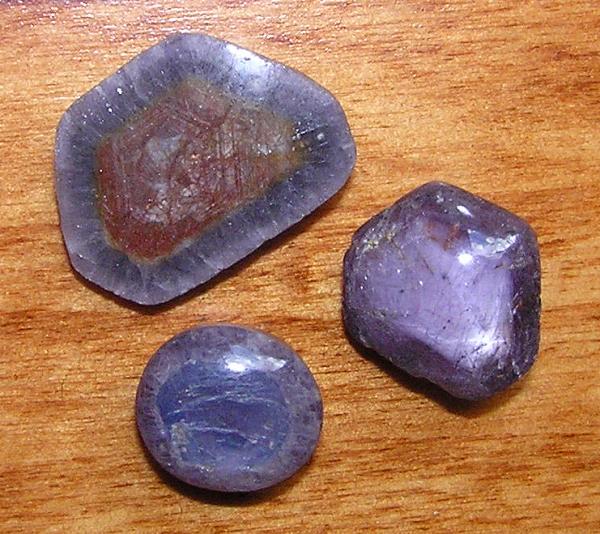
|
| Description: |
| Slice at right-hand side in above photo showing asterism in point source light. |
|
| Viewed: |
21866 Time(s) |
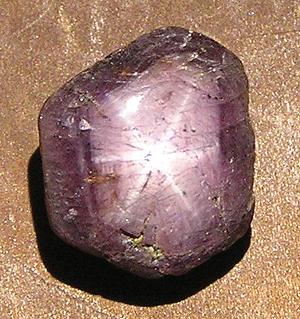
|
_________________
Elise Skalwold |
|
| Back to top |
|
 |
alfredo
Site Admin

Joined: 30 Jan 2008
Posts: 1014



|
 Posted: Aug 31, 2010 20:38 Post subject: Re: Spinel overgrowth on corundum Posted: Aug 31, 2010 20:38 Post subject: Re: Spinel overgrowth on corundum |
|
|
Looks like interesting stuff, elise!
Whether they are pseudomorphs or not depends on the timing of events. If it originally grew as all corundum, with the outer layer later replaced by spinel, then you would call it a "spinel pseudomorph after corundum", or the pedants might say "partial pseudomorph of spinel after corundum" (as you already noted), since the replacement doesn't go all the way through. If however a corundum grew first and was later overgrown by a layer of spinel (which is what I suspect happened here, because of the sharpness of the corundum boundary), then it's an overgrowth, and I personally wouldn't call it a pseudomorph, although some might. (What was the definition of "perimorph" again? i forget.)
|
|
| Back to top |
|
 |
Elise

Joined: 22 Dec 2009
Posts: 243
Location: New York State



|
 Posted: Aug 31, 2010 21:13 Post subject: Re: Spinel overgrowth on corundum Posted: Aug 31, 2010 21:13 Post subject: Re: Spinel overgrowth on corundum |
|
|
| alfredo wrote: | | Looks like interesting stuff, elise!) |
Hey - that was fast! I was thinking about it after I wrote -- "overgrowth" seems self-explanatory, but maybe not always obvious considering specimens where it might be hard to determine if it "grew over" or was in the process of "taking over." In partial pseudomorphs would there ever be a sharp boundary of change making it difficult to tell which was happening?
By the way, this is one of the chiastolites I was telling you about: https://www.mineral-forum.com/message-board/viewtopic.php?p=13065#13065 It is a good thing I like to collect inexpensive oddities; allows for being able to afford the "Minerals and Precious Stones of Brazil" book https://www.mineral-forum.com/message-board/viewtopic.php?t=1251 - my main purchase at the show.
Elise
_________________
Elise Skalwold |
|
| Back to top |
|
 |
mmauthner
Joined: 30 May 2007
Posts: 113
Location: Graz


|
 Posted: Aug 31, 2010 23:22 Post subject: Re: Spinel overgrowth on corundum Posted: Aug 31, 2010 23:22 Post subject: Re: Spinel overgrowth on corundum |
|
|
Hi Elise,
Yogo Gulch sapphires, I believe, commonly have an overgrowth of spinel (pleonaste). I have a slide of that somewhere that I took for a friend of mine (Guylaine Gauthier) who did her thesis on these. I cannot remember what the interpretation was though, in terms of overgrowth vs reaction rim vs pseudomorphism. I also have a specimen in my collection.
There are also corundum pseudomorphs after spinel from Dewitt's Corners, Ontario. These probably are true pseudomorphs as they are brown octahedra. I used to have an example that was completely pseudomorphed on the outside and another that was partially pseudomorphed.
Mark
|
|
| Back to top |
|
 |
crocoite

Joined: 06 Feb 2009
Posts: 490
Location: Ballarat, Victoria



|
 Posted: Sep 01, 2010 03:06 Post subject: Re: Spinel overgrowth on corundum Posted: Sep 01, 2010 03:06 Post subject: Re: Spinel overgrowth on corundum |
|
|
These are really interesting. I haven't seen them before. Thanks for sharing Elise.
One other generally noted characteristic of pseudomorphs is that they are generally dull on the surface.
Regards
Steve
|
|
| Back to top |
|
 |
Jordi Fabre
Overall coordinator of the Forum

Joined: 07 Aug 2006
Posts: 5092
Location: Barcelona



|
|
| Back to top |
|
 |
Elise

Joined: 22 Dec 2009
Posts: 243
Location: New York State



|
 Posted: Sep 01, 2010 08:15 Post subject: Re: Spinel overgrowth on corundum Posted: Sep 01, 2010 08:15 Post subject: Re: Spinel overgrowth on corundum |
|
|
Just a quick added note - the prism faces are still intact on the pink stone and apparently lightly sanded off on the brown one; both show even growth of spinel (the blue one is completely rounded and polished on the sides unfortunately).
I hate to bring up massive vs single crystal again, but is the spinel growth in this case multi-crystalline? It seems to be radial. I haven't digested all of the discussion in Jordi's link yet, so that question might be going down the same path already hashed out.
Elise
_________________
Elise Skalwold |
|
| Back to top |
|
 |
Pete Richards
Site Admin
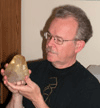
Joined: 29 Dec 2008
Posts: 846
Location: Northeast Ohio



|
 Posted: Sep 01, 2010 08:45 Post subject: Re: Spinel overgrowth on corundum Posted: Sep 01, 2010 08:45 Post subject: Re: Spinel overgrowth on corundum |
|
|
If the spinel is replacing the corundum, the boundary between the two is unlikely to be sharp and uniform, at least at a fine scale. Pseudomorphs generally are polycrystalline, whereas overgrowths can be (but need not be) more nearly single-crystal, especially if epitaxy is involved. Epitactic overgrowths involve one to many crystals with the same (or equivalent) orientations. However, oriented replacements (topotaxy) also occur and are a special case of pseudomorphy.
In other words, there's no sure way to tell whether these are overgrowths or replacements! It's a judgement call based on geometry and texture.
_________________
Collecting and studying crystals with interesting habits, twinning, and epitaxy |
|
| Back to top |
|
 |
John S. White
Site Admin

Joined: 04 Sep 2006
Posts: 1298
Location: Stewartstown, Pennsylvania, USA



|
 Posted: Sep 01, 2010 10:44 Post subject: Re: Spinel overgrowth on corundum Posted: Sep 01, 2010 10:44 Post subject: Re: Spinel overgrowth on corundum |
|
|
Well I will put in my two cents for what it is worth. To me this looks like an overgrowth of spinal on unaltered corundum. If we were seeing pseudomorphism then I feel that the corundum would not appear completely unaltered. I suspect that it would show some deterioration. Furthermore, the spinel appears quite transparent, a condition that one would not expect to see in a pseudomorph. The sharp boundary between the two phases also argues forcefully for overgrowth instead of replacement.
_________________
John S. White
aka Rondinaire |
|
| Back to top |
|
 |
Pete Richards
Site Admin

Joined: 29 Dec 2008
Posts: 846
Location: Northeast Ohio



|
 Posted: Sep 01, 2010 11:06 Post subject: Re: Spinel overgrowth on corundum Posted: Sep 01, 2010 11:06 Post subject: Re: Spinel overgrowth on corundum |
|
|
I suppose it's worth asking whether it is known that the outer part is indeed spinel and not blue corundum?
In spite of my previous posting, I agree that it looks more like an overgrowth than a replacement.
_________________
Collecting and studying crystals with interesting habits, twinning, and epitaxy |
|
| Back to top |
|
 |
John S. White
Site Admin

Joined: 04 Sep 2006
Posts: 1298
Location: Stewartstown, Pennsylvania, USA



|
 Posted: Sep 01, 2010 12:19 Post subject: Re: Spinel overgrowth on corundum Posted: Sep 01, 2010 12:19 Post subject: Re: Spinel overgrowth on corundum |
|
|
Good question from Pete, it would be nice to know how spinel was verified. I would also like to add that epitaxy is a good possibility if it is spinel. Nassau (Gems Made By Man) pointed out that spinel and corundum have very similar crystal structures.
_________________
John S. White
aka Rondinaire |
|
| Back to top |
|
 |
Elise

Joined: 22 Dec 2009
Posts: 243
Location: New York State



|
 Posted: Sep 01, 2010 13:38 Post subject: Re: Spinel overgrowth on corundum Posted: Sep 01, 2010 13:38 Post subject: Re: Spinel overgrowth on corundum |
|
|
| John S. White wrote: | | Good question from Pete, it would be nice to know how spinel was verified. |
I found photos this morning in a book on Mogok which show several examples consistent with these, but no explanation of the genesis nor any references. I did just get off the phone with Bill Bassett - he said we have time soon on several instruments in someone's else's lab for other work we are doing. I don't see why I can't slip these in and get a definitive answer on what is making up the rim. Meanwhile, some close-ups of the rind area.
| Description: |
| close-up of the rim of the brown specimen. |
|
| Viewed: |
21697 Time(s) |
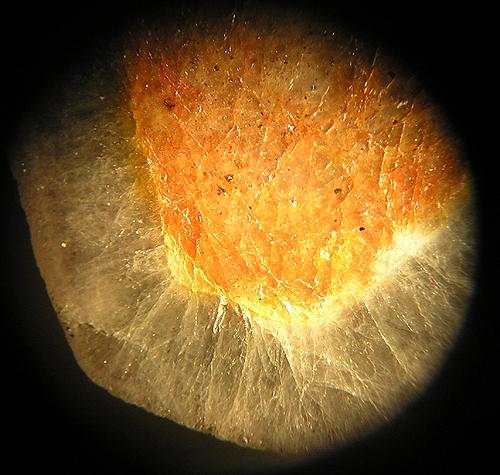
|
| Description: |
| Notice the second rim just visible on the far right edge. |
|
| Viewed: |
21698 Time(s) |
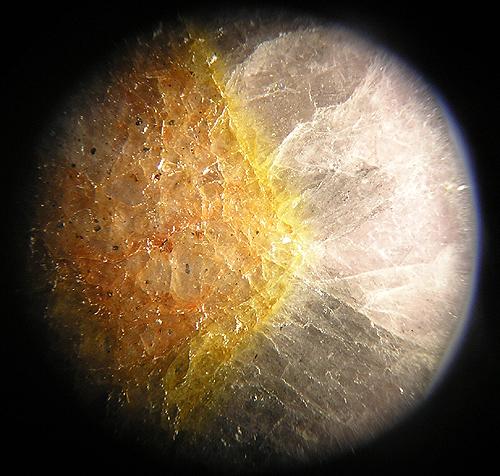
|
| Description: |
| closer view of the transition area. |
|
| Viewed: |
21659 Time(s) |
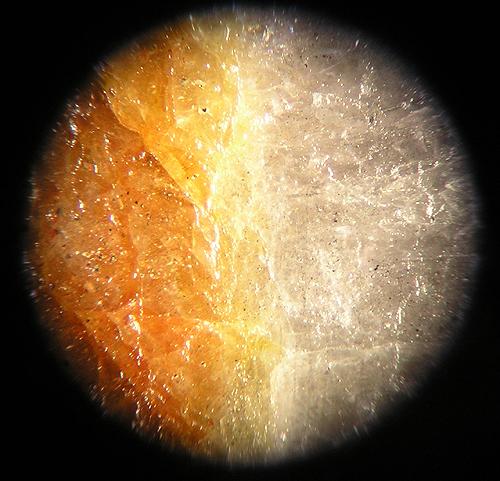
|
_________________
Elise Skalwold |
|
| Back to top |
|
 |
Elise

Joined: 22 Dec 2009
Posts: 243
Location: New York State



|
 Posted: Sep 04, 2010 21:08 Post subject: Re: Spinel overgrowth on corundum Posted: Sep 04, 2010 21:08 Post subject: Re: Spinel overgrowth on corundum |
|
|
I ran across an entry in Gems & Gemology Journal, Fall 1992 reporting a colorless corundum crystal with overgrowth of first a thin dark green spinel layer, followed by an outside layer of dark blue sapphirine (layers were confirmed by X-ray diffraction). Actually, it states "intergrown;" I assumed overgrowth. There is a photo of the 14.02x8.13x5.94 mm crystal which outwardly looks like corundum and is reportedly to be from Betroka, Madagascar. The same entry also mentions the "intergrowth" of sunstone feldspar and iolite (India) - similar to what my friend sent me from Norway - that actually seems to be the correct use of the term (?) - there is a picture I posted here of that: https://www.mineral-forum.com/message-board/viewtopic.php?p=10290&highlight=#10290
Best wishes,
Elise
_________________
Elise Skalwold |
|
| Back to top |
|
 |
|




